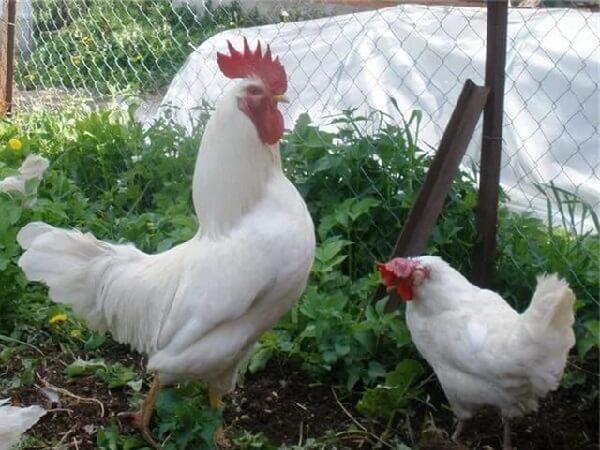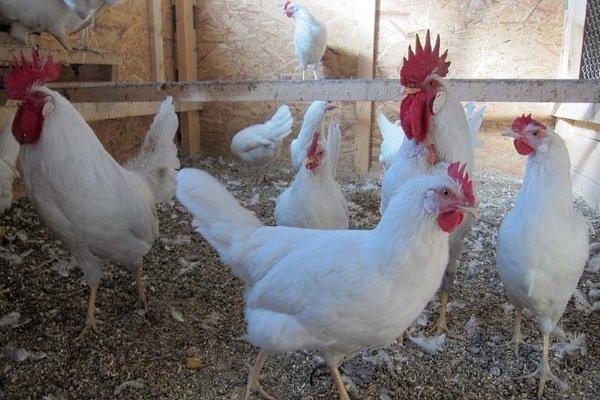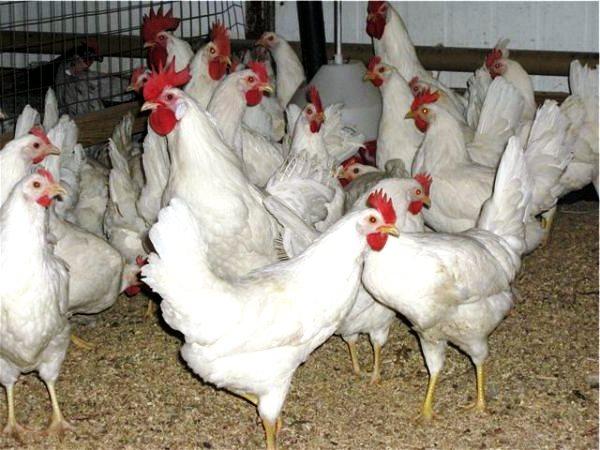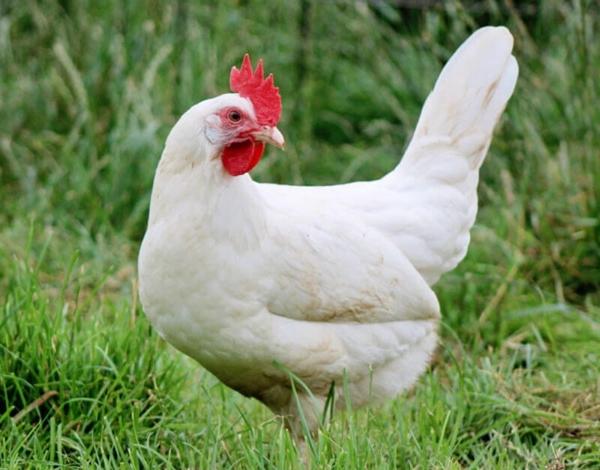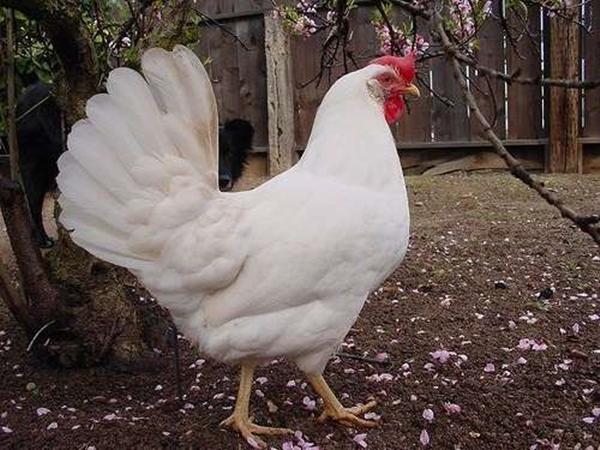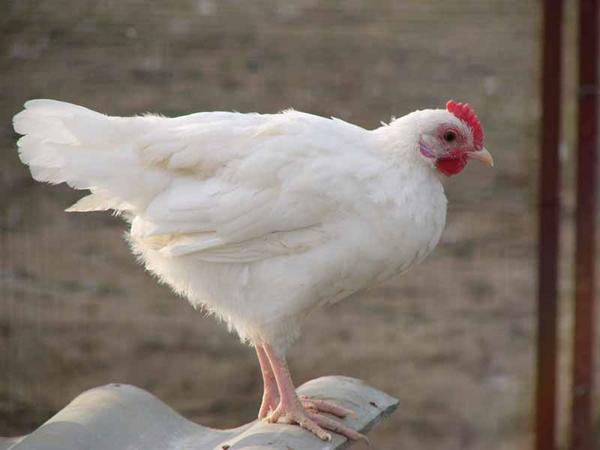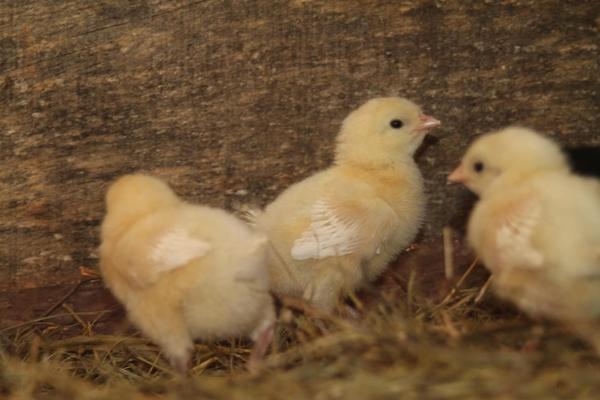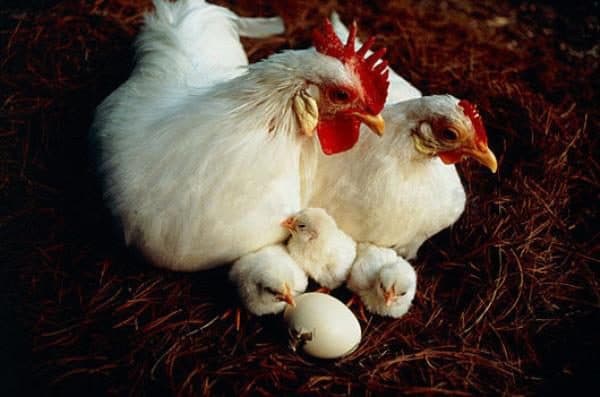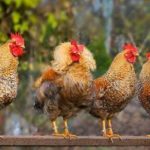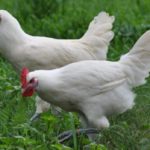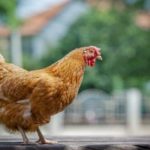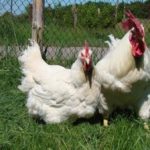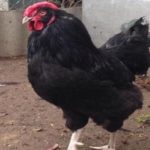The Russian White chicken breed is considered quite popular. These birds are characterized by high productivity and strong immunity. They develop quickly, easily tolerate cold and easily adapt to external conditions. To achieve success in breeding birds, it is necessary to properly organize the poultry house and space for walking. A rational and balanced diet is of no small importance.
- History of the breed
- Description and characteristics of Russian White chickens
- Appearance
- Productive qualities
- Character
- Main advantages and disadvantages
- Features of maintenance and care
- Poultry house requirements
- Walking yard, feeders and drinking bowls
- Molting and break in egg production
- Planned herd replacement
- Chicken diet
- Feeding the chickens
- Nutrition for adult laying hens
- Subtleties of breeding
- Frequent illnesses and prevention
- Where can I buy in Russia?
History of the breed
Chickens of this breed have a long history of origin. They began to be bred back in the thirties of the last century. At the same time, the final completion of selection occurred in the fifties.
basis the breed became famous Leghorns. To adapt to the harsh climate, they were crossed with local chickens. As a result, we managed to obtain an interesting combination of high egg production and strong immunity.
Initially, the Russian White breed included 2 populations - Pyatigorsk and Kuchinsky. However, today there are no differences. Chickens are a single egg-laying breed. Their characteristics are completely identical.
In the mid-seventies, these chickens were the most popular breed in the Soviet Union. They were raised in poultry farms and small farms. Today they have somewhat lost ground to foreign crosses, but are still among the most productive egg breeds.
Description and characteristics of Russian White chickens
This breed is characterized by a number of interesting features. They are definitely worth studying before starting bird breeding.
Appearance
Russian White chickens are characterized by the following features:
- large leaf-shaped comb, including 5 teeth;
- the middle head is round in shape;
- Red eyes;
- white earlobes with slight thickening;
- not very long thick neck;
- wide, rounded chest;
- a small tail located at a right angle to the back;
- stocky yellow limbs;
- white feathers that do not fade into other colors.
Productive qualities
Chickens are light in weight. Adult laying hens weigh 1.8-2.4 kilograms, roosters can reach 3 kilograms. Birds are raised for eggs.During the year, a chicken can lay 200-250 eggs. They are covered with a white shell and weigh 55-60 grams. The first clutch is observed at 5 months.
The laid eggs are 95% fertilized. Chick survival rates reach 92-94%. They develop well and quickly gain body weight.
Chickens are distinguished by their unpretentiousness to living conditions.
Character
Birds of this breed are characterized by a calm disposition. They easily endure stress - transportation to a new place or changing the chicken coop. At the same time, productivity parameters do not fall. Roosters do not show aggression. Exceptions include pronounced hazards. In this case, they rush to protect the herd.
Main advantages and disadvantages
The key advantages of chickens of this breed include the following:
- strong immunity;
- resistance to stress factors;
- rapid puberty;
- excellent productivity;
- ease of care;
- quick adaptation to new conditions;
- resistance to cold;
- saving on feed.
However, chickens also have certain disadvantages. Because they have white feathers, the coop and enclosures need to be kept clean. Also, the disadvantages include the following:
- small egg size;
- not too high taste characteristics of meat;
- increased fearfulness.
Features of maintenance and care
To achieve high productivity parameters and avoid the development of diseases, it is worth providing birds with high-quality care.
Poultry house requirements
Chickens of this breed easily adapt to different conditions. They can be kept in free range chicken coops or placed in cages. In order for chickens to develop normally, it is worth considering several features:
- The optimal temperature is +14-19 degrees. Birds can hardly tolerate temperatures above +27 degrees.
- Chickens can overwinter in an unheated chicken coop. However, at temperatures less than -2 degrees, they can freeze the scallops.
- To save space in the chicken coop, it is worth equipping the room with multi-level perches.
- It is recommended to place nests in dark places. There should be 1 nest for 5-6 individuals.
- There should be 1 rooster for every 10 hens. It's also worth using one spare.
The use of bedding is important. It is made from rough materials. It is recommended to disinfect the chicken coop every year. After 1.5 years, egg production parameters decrease.
Walking yard, feeders and drinking bowls
The poultry yard should be fenced with a high fence, since chickens of this breed fly well. When arranging a walking area, it is worth considering the following features:
- Make a frame around the patio.
- Pull the mesh around the outer sides. Its cells should be less than 5 centimeters.
- Leave a hole from the chicken coop into the walking yard.
- Arrange the territory. It is important that water does not stagnate on the site and dangerous plants do not grow.
- In the warm season, install drinking bowls and feeders. It is recommended to cover them with a canopy to prevent rainwater from getting into the food.
Molting and break in egg production
During the molting period, the following symptoms appear:
- decreased appetite;
- decrease in physical activity;
- deterioration in appearance.
Also at this time there is a break in egg production. During this period, it is worth providing the birds with additional food. After 2 months, the chickens will start laying eggs again.
Planned herd replacement
Chickens produce a large number of eggs up to 1.5 years. Then their productivity decreases significantly. During this period, it is worth carrying out a planned replacement of the herd.
Chicken diet
In order for birds to develop normally and fully lay eggs, it is recommended to provide proper nutrition. It is selected taking into account age.
Feeding the chickens
Chickens should be fed boiled eggs mixed with cereals and herbs. Chicks also need cottage cheese and yeast. A little later they should be given vegetables. At the age of 1 month, birds can be fed like adults.
Monitoring the cleanliness of drinkers and feeders is of no small importance. It is important to perform preventive disinfection once a day.
Nutrition for adult laying hens
The feeding habits of adult birds depend on the conditions of their keeping. The breed is considered physically active and does not have a tendency to become obese.
However, when grown in cells, metabolic processes deteriorate and productivity decreases. Such birds need less nutritious food.
The daily amount of food should be divided into 3 doses. The average amount of feed is 170 grams. The following components should be present in the diet of chickens:
- concentrates – they account for 40% of the feed;
- compound feed;
- greenery;
- vegetables;
- cereals;
- fish and meat and bone meal;
- yeast;
- flax seeds;
- vitamins and minerals.
Free-range chickens eat pasture. They are allowed to be fed 2 times a day. In winter, the number of meals is increased to 3.
Subtleties of breeding
The breed has practically not retained the brooding instinct, therefore it is recommended to hatch chickens using the incubation method or use chickens of other species for this.
For breeding, you should choose white eggs weighing at least 60 grams. They can be stored for a maximum of 2 weeks in a cool place. Chickens of this breed are characterized by high survival rates. They reach 94-99%.
Frequent illnesses and prevention
This breed is characterized by strong immunity against most diseases. At the same time, experienced poultry farmers advise carrying out important measures:
- vaccinate chickens in a timely manner;
- choose medium-sized, high-quality eggs;
- strictly observe the temperature regime in the incubator;
- keep the chicks in a dry and warm room that is well ventilated;
- avoid crowding, as this causes the development of various diseases;
- provide birds with adequate nutrition, which contains many vitamins, minerals, and herbs.
Where can I buy in Russia?
You can buy birds of this breed in different places. They are sold at the Maryinsk and Adler poultry farms. Also Moscow sells chickens VNITIP and the Pushkin gene pool, located in St. Petersburg. The price of eggs ranges from 30 to 90 rubles per piece. The average cost of chicks is 400-500 rubles.
Russian White chickens are characterized by high productivity, resistance to low temperatures, and strong immunity. That is why many poultry farmers grow them. To achieve success in breeding birds, you need to provide them with normal living conditions.

